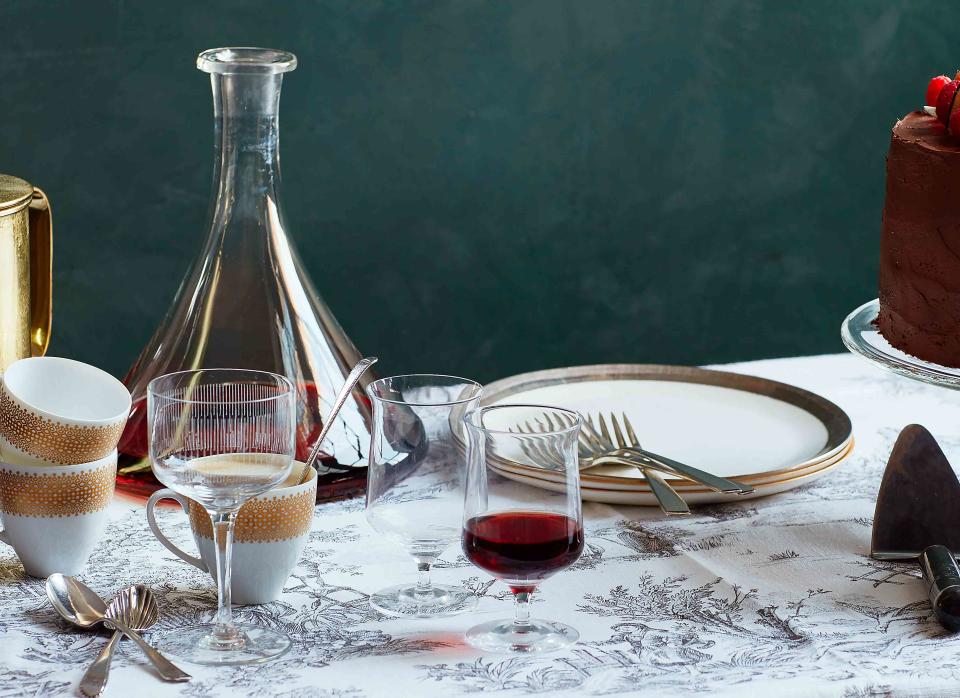10 Dessert Wines to Sip for a Sweet Ending to Any Meal
From sherry and port to sparkling Moscato, try one of these dessert wines for a glorious finish.

Yuki Sugiura
From reunion dinners with close friends to romantic suppers for two, certain occasions just seem to call for a little something extra extra. That's the time to cap off a meal with dessert wine, savoring those moments of togetherness with each sip. But wait, maybe you've determined you're not a fan of dessert wines. If so, chances are you just haven't found a style that's right for you. After all, this diverse category boasts a mind-boggling variety—and despite its name, not every selection is sugar-sweet. These wines are wonderful paired with everything from chocolate cake to a cheese board. Or you can skip the dessert course and go straight to dessert wine, say, glasses of Sauternes, ice wine, or port. Ahead, learn more about dessert wine, including what desserts and cheeses they pair well with.
Related: How to Pair Wine with All of Your Favorite Brunch Dishes
What is Dessert Wine?
Some are slightly sweet, others somewhat syrupy. Not surprisingly, all dessert wines start with grapes that have a very high natural sugar content. During the fermentation process, that natural sugar is converted into alcohol; wines that have all the sugar fermented out of them are referred to as "dry." In the case of dessert wine, winemakers stop the fermentation early so the natural sweetness remains. Dessert wines can be red, white, or rosé and can range from just a whisper of sweetness to a full-on sugar bomb. The key to a fantastic dessert wine is high acidity, which keeps all that sweetness from being too cloying and lends complexity, vibrancy, and "lift" to the drinking experience.
Sparkling Dessert Wine
Light and typically low in alcohol, these effervescent wines are festive and fun for any time of day. Look for sweet sparklers made from muscat, brachetto, riesling, or Torrontés grapes. These wines are also wonderful at brunch or paired with fresh fruit desserts like orange and yogurt tart or a simple fruit platter with whipped ricotta.

Concentrated, Rich Dessert Wine
There are a few different ways to make these incredibly rich wines. With the following methods, steps are taken to concentrate the sugar in the grapes before crushing.
Late-harvest wine: With this process, the grapes are left on the vine until very late into the growing season, so they get maximum sugar levels, sometimes even through the first frost for what is known as ice wine.
Passito method: This way of making concentrated dessert wines entails drying grapes on straw mats, essentially making sweet raisins before turning them into wine.
Noble rot: Some grapes take on a fungus called botrytis (or, noble rot), which evaporates the water and concentrates the sugars—it sounds unappetizing, but the result is magical.
Lush and decadent, these dessert wines, including Sauternes, tokaji, and vin santo, have a luscious, thick mouthfeel and complex flavors like honey, marmalade, and spices. Blue cheese is a classic pairing: try dates and blue cheese or blue cheese gougeres with caramel and salt.
Fortified Wine
Another method is to make a fortified wine, which means some brandy is added to the fermenting grape juice. That, in turn, stops the fermentation and preserves some of the residual sugar—and incidentally kicks up the alcohol content. Fortified wines usually range from 18-20 percent alcohol, perfect for keeping warm in the winter months.
Port
Port, which hails from Portugal, is also considered a fortified wine. It's the perfect bookend to a lavish meal. There are two main styles of port:
Ruby port: This style has more dark, rich fruit to it and is a classic pairing with chocolate truffles.
Tawny port: Look for butterscotch, caramel, and nutty notes. Try a tawny port with a cheese platter for a perfect after-dinner treat.
Sherry
A fortified wine from Andalucía on the southern coast of Spain, sherry runs the spectrum from bone-dry and delicate to wildly rich and sweet. So, while the dry styles like fino and Amontillado are enjoyed as aperitifs and are making a comeback on bar menus as a base for cocktails, dessert sherries skew sweet with indulgent flavors like chocolate, toffee, nuts, and figs. For dessert, look for sherries in these three styles:
Cream sherry: Velvety and full-bodied, this style has aromas of vanilla and roasted nuts. It's delicious with custard-based desserts like flan or crème caramel.
Moscatel sherry: Floral, with distinct fruity notes, this sherry is usually served chilled to highlight its flavors. Try it with chocolate and hazelnut-rich desserts.
Pedro Ximenez (PX): Made from sun-dried grapes, this style is the sweetest of the trio; pour PX over ice cream or team it with a fruit tart.
Madeira
Originally made to endure rough seas and intense conditions, this fortified wine never spoils. It is named for its birthplace, Madeira, an island 400 miles off the North African coast. From the 15th to the 17th centuries, Madeira was a stopping point for ships traveling to the New World and the East Indies. The first Madeiras were created as wine that could stand up to travel: to prevent it from spoiling on its voyage, brandy was routinely added to the barrel. Then, the intense heat from sailing around the equator and the constant movement of the ships naturally concentrated and oxidized the wine.
Madeira Today
Nowadays, these natural effects are duplicated by other means in the winery; in the highest quality Madeira, the wines are aged in oak in the heat of the sun and slowly mature in the warm and humid climate of the island. It's because Madeira is already essentially "cooked" that it never spoils: There is Madeira from the late 18th century still around today, and it is perfectly drinkable. Try a Madeira (though maybe not a 200-year-old one!) with sticky toffee pudding or hazelnut cookies.
Read the original article on Martha Stewart.

